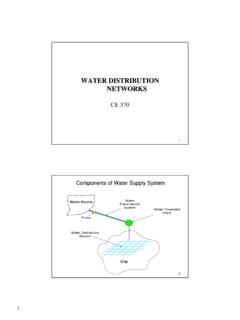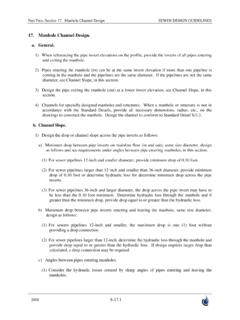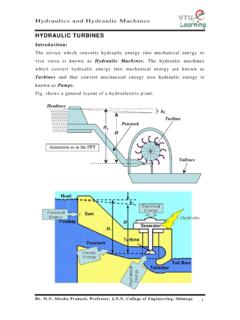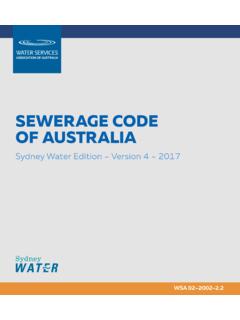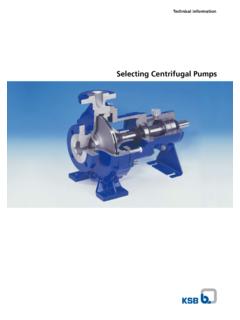Transcription of Water Audits and Water Loss Control For Public Water ...
1 1 Water Audits AND Water LOSS Control FOR Public Water SYSTEMS The Water Loss Problem Public Water systems face a number of challenges including aging infrastructure, increasing regulatory requirements, Water quantity and quality concerns and inadequate resources. These challenges may be magnified by changes in population and local climate. It has been estimated that: The United States. will need to spend up to $200 billion dollars on Water systems over the next 20 years to upgrade transmission and distribution Of this amount, $97 billion (29 percent) is estimated to be needed for Water loss Average Water loss in systems is 16 percent up to 75 percent of that is A Water loss Control program can help Water systems meet these challenges.
2 Although it requires an investment in time and financial resources, management of Water loss can be cost effective if properly implemented. The time to recover the costs of Water loss Control is typically measured in days, weeks, and months rather than A Water loss Control program will also help protect Public health through reduction in potential entry points for disease causing pathogens. Understanding Water Use and Water Loss Much of the drinking Water infrastructure in the United States has been in service for decades and can be a significant source of Water loss through leaks.
3 In addition to leaks, Water can be lost through unauthorized consumption (theft), administrative errors, data handling errors, and metering inaccuracies or failure. The International Water Association (IWA) and the American Water Works Association (AWWA) have developed standard terminology and methods to assist Water systems in tracking Water losses and in performing Water Audits . The standard terminology includes the terms authorized consumption, real loss, apparent loss and non revenue Water that are used in this document. Authorized Consumption is Water that is used by known customers of the Water system.
4 Authorized consumption is the sum of billed authorized consumption and unbilled authorized consumption and is a known quantity. It also includes Water supplied to other Water systems. Introduction This document provides an introduction to Water loss Control and information on the use of Water Audits in identifying and controlling Water losses in Public Water systems. Water Audits are the first step in a three step process for controlling Water loss. A Water audit is followed by intervention to identify losses and implement solutions and then by an evaluation of intervention measures and the needs for further improvement.
5 This document is intended for small and medium sized Water systems, as well as state programs and technical assistance providers that regulate or support these systems. 2 Real losses , also referred to as physical losses , are actual losses of Water from the system and consist of leakage from transmission and distribution mains, leakage and overflows from the Water system s storage tanks and leakage from service connections up to and including the meter. Apparent losses , also referred to as commercial losses , occur when Water that should be included as revenue generating Water appears as a loss due to unauthorized actions or calculation error.
6 Apparent losses consist of unauthorized consumption, customer metering inaccuracies, and systematic data handling errors in the meter reading and billing processes. Non Revenue Water (NRW) is Water that is not billed and no payment is received. It can be either authorized, or result from apparent and real losses . Unbilled Authorized Consumption is a component of NRW and consists of unbilled metered consumption and unbilled un metered consumption. What are the Benefits of a Water Loss Control Program? A Water loss Control program helps to identify real or physical losses of Water from the Water system and apparent losses , the Water that is consumed but not accounted for.
7 Real losses represent costs to a Water system through the additional energy and chemical usage required to treat the lost Water . Apparent losses represent a loss of revenue because the Water is consumed but not accounted for and thus not billed. Once a Water system identifies these real and apparent losses through a Water loss Control program, it can implement controls to reduce them. This can reduce the need for costly upgrades and expansions due to population growth and increased demand. By reducing the amount of Water lost, the recovered Water can be sold to consumers, generate revenue and meet Water demands.
8 In some cases this can reduce the need to find additional sources. Water loss Control programs are often the most economical solution to increasing demand, especially in the short What Does a Water Loss Control Program Look Like? A Water loss Control program consists of three major steps (see Figure 1). The critical first step is the Water audit. A Water audit identifies and quantifies the Water uses and losses from a Water system. The intervention process addresses the findings of the Water audit through implementation of controls to reduce or eliminate Water losses .
9 The evaluation step uses performance indicators to determine the success of the chosen intervention actions. Utilizing the standard terminology and the three steps of a Water loss Control program, systems can determine their baseline Water use and loss, prioritize and implement Water efficiency projects and operational changes, and evaluate and continuously improve their Water loss Water AuditInterventionEvaluationFigure 1. Components of a Water Loss Control Program 3 management. Figure 2 provides a summary of the main data needs, action items and performance indicators for each step of a Water loss Control program.
10 The following sections will go into more detail for each step. Step 1 Water Audit Data Needs Gathering information. Determining flows into and out of the distribution system based on estimates or metering. Calculating the performance indicators. Assessing where Water losses appear to be occurring based on available metering and estimates. Analyzing data gaps. Considering options and making economic and benefit comparisons of potential actions. Selecting the appropriate 2 Intervention Action Items Gathering further information, if necessary.










